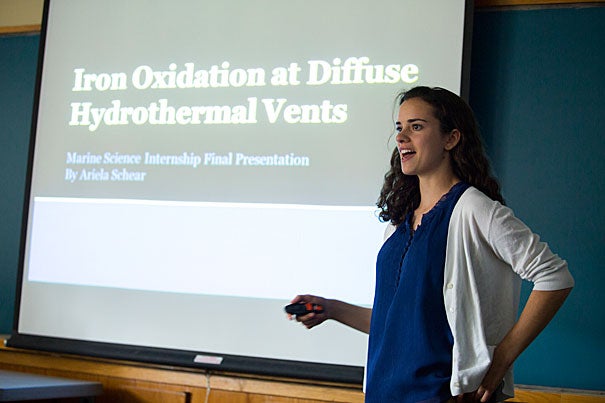
Ariela Schear (photo 1) and Andre Dempsey (photo 2) were among three Cambridge Rindge and Latin students who interned in Harvard’s marine biology labs this year. The students presented their work before Harvard Professor Peter Girguis (left, photo 3) and teacher Paul McGuinness.
Stephanie Mitchell/Harvard Staff Photographer
Insights for high school students
Three from Rindge and Latin intern at marine biology labs
Three Cambridge Rindge and Latin School students who interned in Harvard’s marine biology labs during the spring recently shared their semester-long projects with their teachers, Harvard mentors, and family members. As they related their experiences, they talked about the obstacles they had to overcome that gave them glimpses into the world of professional researchers.
“All three of these students had a classic experience in the Girguis lab, one that all scientists must learn,” said Peter Girguis, a professor of organismic and evolutionary biology. “You never know what’s going to happen.”
“Well, I guess that’s science,” said Rindge and Latin senior Andre Dempsey, who attended the program showcase along with fellow interns Caspian Harding and Ariela Schear, and their high school marine biology teacher, Paul McGuinness.
The collaboration between Harvard and the high school is formally in its first year, but there are hopes to extend and expand the program. “These students were the trailblazers, and I think the project was a resounding success,” said McGuinness.
“Harvard has been laying the groundwork for this for years. We’ve been able to give students exposure to a research lab and allow them to experience the joy of discovery, innovation, and the challenges associated with it,” said Girguis. “Harvard has been continuing to lay the mechanisms for ways in which Cambridge high school students can gain real-world experience in research.”
John Cisternino, Harding’s father, said that it’s been “really eye-opening as a parent to see how much — and how quickly — [Caspian] has fallen in love with marine biology. To see that he’s already discovered his passion for it in high-school … I really couldn’t ask for a better situation.”
“His initial courses with Paul [McGuinness] and this experience with Pete [Girguis] allowed him to do high-level work on the front lines — not just passively sit back and receive information,” Cisternino continued.
Harding, who presented “Not Your Average Worm,” which examined shipworm cultivation, said the experience taught him many things. “I think the common perception is that you go in and simply do an experiment. What I didn’t anticipate was the entire process as a whole, the process leading up to the actual experiment, the research, the planning. It changed my perceptions about what goes on in marine biology,” he said.
Dempsey, who plans to attend Harvard in the fall, examined extracellular electron transfer (EET), where proteins are used to reduce electron receptors, as well as the use of microbial fuel cells (MFCs) in wastewater treatment. Schear presented a project on biological iron oxidation in hydrothermal vents.
The students thanked their Harvard mentors, Girguis, and McGuinness, of whom Shear said, “I would never have been interested in marine science in the first place if it weren’t for him.”
The program is one of many at Harvard that engage local students. To learn more about the University’s partnerships with local schools, visit Harvard Community Connections.




